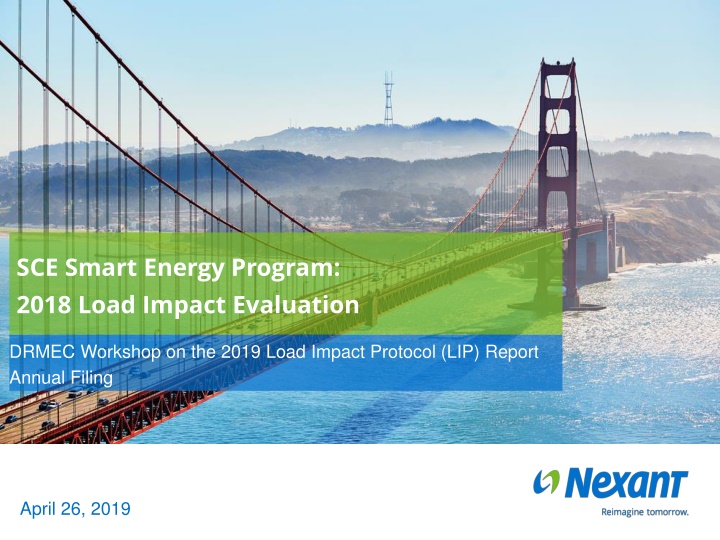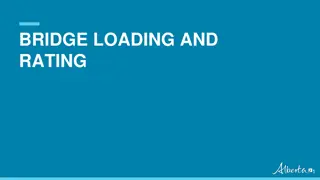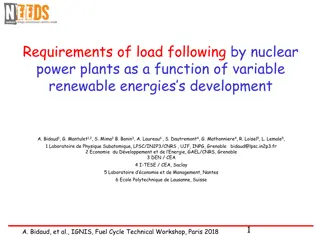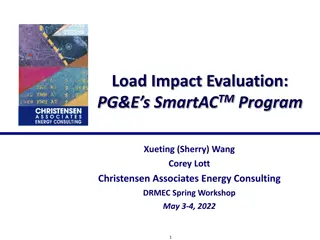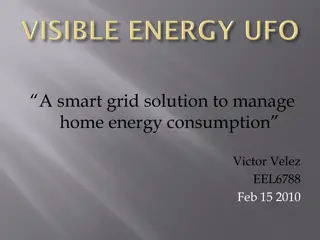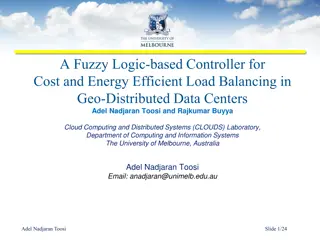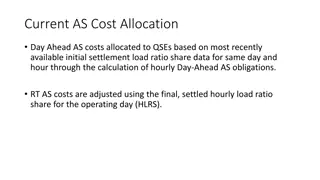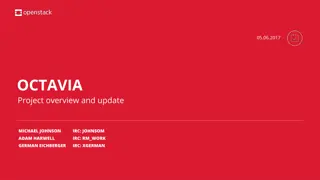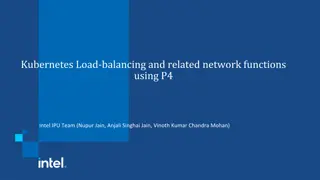SCE Smart Energy Program: 2018 Load Impact Evaluation
This report evaluates the load impact of the SCE Smart Energy Program in 2018, as discussed in the DRMEC Workshop on the 2019 Load Impact Protocol. The findings and insights presented in the annual filing on April 26, 2019, provide valuable information on the program's effectiveness and performance. The evaluation highlights key metrics, trends, and outcomes that shed light on the energy program's impact on overall energy consumption and efficiency. Stakeholders and industry professionals can leverage this report to make informed decisions and enhance energy management strategies.
Download Presentation

Please find below an Image/Link to download the presentation.
The content on the website is provided AS IS for your information and personal use only. It may not be sold, licensed, or shared on other websites without obtaining consent from the author.If you encounter any issues during the download, it is possible that the publisher has removed the file from their server.
You are allowed to download the files provided on this website for personal or commercial use, subject to the condition that they are used lawfully. All files are the property of their respective owners.
The content on the website is provided AS IS for your information and personal use only. It may not be sold, licensed, or shared on other websites without obtaining consent from the author.
E N D
Presentation Transcript
SCE Smart Energy Program: 2018 Load Impact Evaluation DRMEC Workshop on the 2019 Load Impact Protocol (LIP) Report Annual Filing April 26, 2019
Agenda Smart Energy Program overview Ex post methodology Ex post results Ex ante methodology Ex ante results Conclusions and recommendations 2
Smart Energy Program (SEP) Description Load impacts are achieved through SCE-approved but customer- installed programmable communicating thermostats (PCTs) SEP events are called by SCE and dispatched by the PCT manufacturers by remotely raising participants cooling setpoints Event length: 1-4 hours in duration between 11:00 AM and 8:00 PM Availability: Non-holiday weekdays, year-round Restrictions: No more than four hours of load control per day Notification: PCT manufacturers are now given 20 minutes day-of notice, rather than day-ahead precooling no longer feasible Dual-enrollment: Customers are no longer permitted to dually enroll with SDP Customers receive sign-up and capacity payments as incentives to participate Incentives are paid as bill credits on June through September bills Energy payments are eliminated in 2019 but were in place through 2018 3
Summary of 2018 SEP Events Heat Buildup Avg. 12 AM to 5 PM ( F) 70.9 82.9 73.2 76.0 71.2 74.4 Average Event Temp. ( F) Day of Week Dispatch Protocol Event Start Event Stop Event Duration Number of Customers Date Friday Tuesday Thursday Friday Thursday Tuesday M&E/Test Economic Economic Economic Economic Economic 2:00 4:00 4:00 4:00 4:00 4:00 71.8 83.5 74.2 76.5 71.1 73.3 44,848 48,748 51,288 51,344 51,565 52,498 6/8/2018 8/7/2018 9/13/2018 9/14/2018 9/20/2018 10/2/2018 2:00 PM 2:00 PM 2:00 PM 2:00 PM 2:00 PM 2:00 PM 4:00 PM 6:00 PM 6:00 PM 6:00 PM 6:00 PM 6:00 PM SEP Event Reference Loads 3.5 3 Reference Load (kW) 2.5 08/07/18 - Tues. 2 09/14/18 - Fri. 09/13/18 - Thurs. 1.5 09/20/18 - Thurs. 1 06/08/18 - Fri. 0.5 10/02/18 - Tues. 0 1 2 3 4 5 6 7 8 9 10 11 12 13 14 15 16 17 18 19 20 21 22 23 24 Hour 4
Ex Post Methodology Matched control group selected based on 15 proxy days close in temperature to actual event days Each customer was matched for hot, moderate, and cold event days Propensity score matching was performed to select control groups Each participant was matched to a non-participant in the same Abank and with the same CARE status Used difference-in-differences fixed effects regression model to estimate impacts Moderate High Cool 5
2018 Ex Post Impacts Heat Buildup Avg. 12 AM to 5 PM ( F) Avg. Load Impact (kW) Aggregate Load Impact (MW) Avg. Avg. Load w/ DR (kW) Number of Customers % Load Impact Snapback (kW) Event Date Reference Load (kW) *6/8/2018 9/20/2018 9/13/2018 10/2/2018 9/14/2018 8/7/2018 Average Event 44,848 51,565 51,288 52,498 51,344 48,748 70.9 71.2 73.2 74.4 76.0 82.9 0.58 1.13 1.32 1.04 1.56 2.54 0.53 0.80 0.92 0.77 1.18 1.80 0.06 0.34 0.40 0.27 0.37 0.74 9.6% 29.7% 30.1% 26.1% 24.0% 29.3% -0.03 -0.09 -0.13 -0.10 -0.11 -0.19 2.5 17.3 20.3 14.2 19.2 36.3 51,089 75.4 1.50 1.08 0.42 27.9% -0.12 21.5 Average Event Day *6/8 TEST EVENT NOT INCLUDED IN AVERAGE EVENT CALCULATON 6
2018 vs. 2017 Ex Post Impacts 2018 Ex Post Summary Heat Buildup Avg. 12 AM to 5 PM ( F) 70.9 71.2 73.2 74.4 76.0 82.9 75.4 Avg. Avg. Load Impact (kW) Aggregate Load Impact (MW) SEP performed nearly identically in 2018 vs. 2017 Same % load reduction Same MW Number of Customers Avg. Load w/ DR (kW) % Load Impact Snapback (kW) Event Date Reference Load (kW) *6/8/2018 9/20/2018 9/13/2018 10/2/2018 9/14/2018 8/7/2018 Average Event 44,848 51,565 51,288 52,498 51,344 48,748 51,089 0.58 1.13 1.32 1.04 1.56 2.54 1.50 0.53 0.80 0.92 0.77 1.18 1.80 1.08 0.06 0.34 0.40 0.27 0.37 0.74 0.42 9.6% 29.7% 30.1% 26.1% 24.0% 29.3% 27.9% -0.03 -0.09 -0.13 -0.10 -0.11 -0.19 -0.12 2.5 17.3 20.3 14.2 19.2 36.3 21.5 However, that is despite a large increase in the number of enrolled customers *6/8 EVENT NOT INCLUDED IN AVERAGE EVENT CALCULATON 2017 Ex Post Summary Heat Buildup Avg. 12 AM to 5 PM ( F) 76.5 76.9 77.5 77.7 78.4 79.3 79.7 80.3 82.2 83.1 83.7 84.1 85.1 86.2 87.8 81.4 Avg. Avg. Load Impact (kW) Aggregate Load Impact (MW) 2018 SEP events were much cooler on average than 2017 Mean17 of 75.4 vs 81.4 ( F) Number of Customers Avg. Load w/ DR (kW) % Load Impact Snapback (kW) Event Date Reference Load (kW) 7/31/2017 6/19/2017 6/21/2017 9/5/2017 6/20/2017 7/6/2017 8/1/2017 8/28/2017 8/2/2017 8/3/2017 8/29/2017 7/7/2017 8/30/2017 8/31/2017 9/1/2017 Avg. 2017 Event 36,066 31,036 25,965 39,141 31,231 32,792 30,333 32,515 35,408 36,460 38,953 32,916 39,031 37,160 32,799 34,120 1.83 1.86 1.94 1.90 2.02 2.07 2.18 2.46 2.08 2.33 2.71 2.53 2.77 2.76 2.94 2.31 1.26 1.23 1.33 1.32 1.39 1.40 1.49 1.78 1.64 1.63 1.98 1.85 2.04 2.09 2.31 1.66 0.57 0.63 0.60 0.58 0.64 0.67 0.69 0.68 0.44 0.70 0.73 0.68 0.73 0.67 0.63 0.64 31.1% 33.7% 31.1% 30.4% 31.5% 32.3% 31.8% 27.6% 21.0% 30.0% 26.8% 26.7% 26.3% 24.2% 21.4% 27.8% -0.15 -0.16 -0.13 -0.16 -0.19 -0.13 -0.19 -0.13 -0.21 -0.28 -0.29 -0.27 -0.24 -0.18 -0.20 -0.21 20.6 19.4 15.6 22.7 19.9 21.9 21.0 22.1 15.4 25.5 28.3 22.2 28.4 24.8 20.7 21.9 Cooler temperatures lead to lower reference loads and lower load impacts Ref. load 1.50 kW vs. 2.31 kW Load imp. 0.42 kW vs. 0.64 kW 7
Ex Ante Assumptions Enrollment expected to increase from 52,795 in October 2018 to 192,970 in 2029 This year forecast Last year forecast 250,000 Enrollment 200,000 150,000 100,000 50,000 0 Year The evaluation specifically projects load impacts expected to be observed during the resource adequacy (RA) window The summer RA window has shifted from 1-6 PM to 4-9 PM The winter RA window is remains unchanged at 4-9 PM Hour Ending RA Window 14 15 16 17 18 19 20 21 Previous RA Window (Apr - Oct) Previous RA Window (Nov - Mar) Current RA Window 8
Ex Post Load Impacts vs. Weather We estimate ex ante load impacts for each hour as a function of heat buildup We note a behavioral component unique to SEP that we don t see in SCE s direct load control program (SDP): Downward trend in magnitude across the four event hours Downward trend in weather responsiveness across the four event hours Event fatigue, potentially occupancy? SDP does not show this strong an effect and they would be likely be subject to the same occupancy patterns. 9
Per customer load impacts SCE 1-in-2 and 1-in-10 Weather Conditions (kW) Month SCE Weather Year May June July August September October 1-in-2 1-in-10 0.45 0.69 0.50 0.64 0.53 0.66 0.66 0.73 0.60 0.79 0.59 0.65 Aggregate load impacts SCE 1-in-2 and 1-in-10 Weather Conditions (MW) 2019 Enrollment Month SCE Weather Year May June July August September October 1-in-2 1-in-10 28.54 43.63 31.58 40.55 33.94 42.15 42.13 46.42 37.81 50.22 37.21 41.38 10
Typical Event Day Aggregate Impacts for SCE 1-in-10 Weather Conditions (MW) Avg. Aggregate Impact (MW) Forecasted Enrollment 140 250000 120 200000 100 # of Customers MW Impact 150000 80 60 100000 40 50000 20 0 0 2019 2020 2021 2022 2023 2024 2025 2026 2027 2028 2029 Forecast Year 11
Comparison to PY 2017 ex ante load impacts per customer impacts for SCE 1-in-10 Weather Conditions (kW) The PY 2017 evaluation estimated SEP as capable of delivering 163 MW on a SCE 1-in-10 September peak day The PY 2018 evaluation estimated 153 MW for the same scenario The difference reflects the net effect of three changes: RA window change Enrollment forecast New PY 2018 ex post data 12
RA Window Change By moving the summer RA window later in the day, there s more load to shed (example here is SCE 1-in-10) : Previous RA Window Previous Current RA Window Current Ref. Load Avg. Customer kW Impact 3.5 Current RA Window Hour Previous RA Window 3 2.5 14 15 16 17 18 19 20 21 0.8 1.0 0.7 0.5 0.4 Load (kW) 2 1.5 1.3 0.9 0.6 0.4 0.4 1 0.5 0 Avg. Hour in RA Window 1 2 3 4 5 6 7 8 9 10 11 12 13 14 15 16 17 18 19 20 21 22 23 24 Hour Ending 0.70 0.73 13
Enrollment and New Information Changes The PY 2017 evaluation projected 229,000 enrolled customers in 2028; the PY 2018 evaluation projects 192,970 enrolled customers in 2029. The PY 2018 events added impacts to the ex ante estimation dataset that were much cooler than the PY 2017 events the new relationship was steeper (lower impacts at cooler temperatures and higher impacts at hotter temperatures) 14
Recommendations and Conclusions SCE should conduct market research to understand the characteristics, sentiments, and behaviors of new SEP customers: How are the characteristics, sentiments and behaviors of SEP participants changing over time? Call events under varying circumstances: Variety of time periods: help establish relationship between load impacts and time of day, particularly during the new RA window. Variety of weather conditions: calling events on cooler summer days will provide valuable data points for ex ante estimation Vendors should provide override information: Help identify conditions under which customers opt out of events 15
Contact Us Candice Potter Principal, Utility Services CPotter@nexant.com (415) 640-2955
